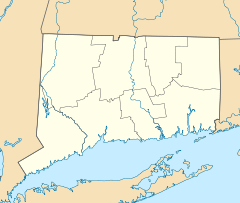- Noank Historic District
-
Noank Historic District
 Noank Baptist Church
Noank Baptist ChurchLocation: Main Street, Groton, Connecticut Coordinates: 41°19′28″N 71°59′20″W / 41.32444°N 71.98889°WCoordinates: 41°19′28″N 71°59′20″W / 41.32444°N 71.98889°W Area: 140 acres (57 ha) Built: 1840 Architect: Multiple Architectural style: Greek Revival, Gothic, Stick-Eastlake Governing body: State NRHP Reference#: 79002656[1] Added to NRHP: August 10, 1979 Noank Historic District is a historic district in the village of Noank in the town of Groton, Connecticut, that was listed on the National Register of Historic Places in 1979.
The district "is of architectural significance because of the number and concentration of interesting houses, particularly the vernacular Greek Revival and Gothic- and Eastlake-detailed dwellings, which line its narrow streets.... The preservation of these buildings' decorative features -- pilasters, bargeboards, peak ornaments, porches and fences -- gives a visual and thematic coherence to this collection of primarily 19th-century domestic architecture."[2]:36
The district boundaries includes almost all of what is known as Noank, including "[a]ll of the Noank Peninsula east of Elm Street [(Route 215)], including parts of Elm Street and Prospect Hill Road," but it excludes certain areas. The nearby Goat Island is not included in the district "because the two or three buildings on it were built after the 1938 hurricane washed away all previous settlement." Also "side streets off Elm are predominantly modern houses that are not related to those in the district."[2]:4
The "chief landmark" of Noank is a Baptist church, at the apex of the village's land. That building "incorporates the 1867 Italianate building, whose twin towers were destroyed in the hurricane."
It includes the Noank Shipyard, at the location of the historic Palmer Shipyard.
It includes a former velvet mill built in 1905, which also was used by the state as a lobster hatchery. The building was used for a time by the University of Connecticut Marine Research Station.[2]:4[3]
Other contributing properties include:
- St. Joseph's Catholic Church, 78 Front Street, shingled and with Gothic details
- a Methodist church, which as of 1978 were re-used as apartments, "also Gothic and shingled, with some unusual Art Nouveau floral windows"[2]:5
- a cobblestone Episcopal Church, used as a museum by 1978, and "one of the few exceptions to the wood-framed norm in Noank building"[2]:5
- the Morgan's Point Lighthouse, an 1868 granite ashlar building with an octagonal tower,
There are about 260 houses in the district, and "[i]t is the domestic architecture of Noank which gives the village its character".[2]:5
See also
References
- ^ "National Register Information System". National Register of Historic Places. National Park Service. 2009-03-13. http://nrhp.focus.nps.gov/natreg/docs/All_Data.html.
- ^ a b c d e f Clouette, Bruce (July 26, 1978). "National Register of Historic Places Inventory-Nomination: Noank Historic District". National Park Service. http://pdfhost.focus.nps.gov/docs/NRHP/Text/79002656.pdf. and Accompanying 30 photos, from 1978
- ^ The University of Connecticut's marine station is now part of its campus at Avery Point. Whether UConn continues to own, or has disposed of, the velvet mill property is unknown.
U.S. National Register of Historic Places Topics Lists by states Alabama • Alaska • Arizona • Arkansas • California • Colorado • Connecticut • Delaware • Florida • Georgia • Hawaii • Idaho • Illinois • Indiana • Iowa • Kansas • Kentucky • Louisiana • Maine • Maryland • Massachusetts • Michigan • Minnesota • Mississippi • Missouri • Montana • Nebraska • Nevada • New Hampshire • New Jersey • New Mexico • New York • North Carolina • North Dakota • Ohio • Oklahoma • Oregon • Pennsylvania • Rhode Island • South Carolina • South Dakota • Tennessee • Texas • Utah • Vermont • Virginia • Washington • West Virginia • Wisconsin • WyomingLists by territories Lists by associated states Other Categories:- Historic districts in Connecticut
- Historic districts in New London County, Connecticut
- Queen Anne architecture in Connecticut
- Greek Revival architecture in Connecticut
- Gothic Revival architecture in Connecticut
Wikimedia Foundation. 2010.


